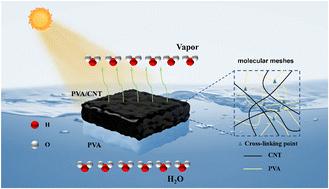CNT/PVA-PVA双层水凝胶界面蒸发器,用于稳定的太阳能脱盐和水净化
IF 5.1
3区 材料科学
Q1 CHEMISTRY, MULTIDISCIPLINARY
引用次数: 0
摘要
基于水凝胶的太阳界面蒸发技术将光热高效地集中在固液气界面,实现了有效的海水淡化,为解决全球淡水危机提供了一个有希望的解决方案,受到了广泛关注。然而,高蒸发速率受到其输水能力和耐盐性的限制。本研究提出了一种湿润梯度双层结构的太阳能驱动水凝胶蒸发器(B-CPVA),具有相对疏水的上层(碳纳米管-聚乙烯醇B-CPVA),用于高效的宽带太阳能吸收和高光热转换,结合亲水的底层(PVA),以促进快速的水输送。通过调整碳纳米管与上层聚乙烯醇的比例,使太阳能热能转换一致,并持续高效蒸发水分。当B-CPVA蒸发器暴露于1.0太阳照度下的模拟海水中时,蒸发速率高达2.40 kg m−2 h−1,效率高达92.85%。此外,在B-CPVA表面形成的NaCl晶体可以在大约53分钟内完全溶解,通过自清洁机制实现有效的除盐。有机溶液(MO和RhB)经该蒸发器处理后无色透明,紫外可见光谱显示其特征吸收带完全消失。证实了该材料优异的污染物净化能力,为太阳能海水淡化应用提供了高效的解决方案。本文章由计算机程序翻译,如有差异,请以英文原文为准。

CNT/PVA-PVA double-layer hydrogel interfacial evaporators for stable solar desalination and water purification
Hydrogel-based solar interface evaporation technology efficiently concentrates photothermal heat at the solid–liquid–gas interface to enable effective seawater desalination, offering a promising solution to the global freshwater crisis and thus attracting extensive attention. However, the high evaporation rate is limited by its water transport capacity and salt tolerance. This work presents a wetting-gradient bilayer structured solar-driven hydrogel evaporator (B-CPVA) featuring a relatively hydrophobic upper layer (carbon nanotubes-polyvinyl alcohol B-CPVA) for efficient broadband solar absorption and high photothermal conversion, combined with a hydrophilic bottom layer (PVA) to facilitate rapid water transport. The proportion of carbon nanotubes to PVA of the upper layer was modified to enable consistent solar thermal energy conversion and sustained high-efficiency water evaporation. The B-CPVA evaporator exhibits a high evaporation rate of 2.40 kg m−2 h−1 with an efficiency of 92.85% when exposed to simulated seawater under 1.0 sun illumination. In addition, the NaCl crystals formed on the B-CPVA surface can be fully dissolved in approximately 53 minutes, achieving effective salt removal through a self-cleaning mechanism. The organic solutions (MO and RhB) treated with this evaporator became colorless and transparent, and UV-visible spectroscopy revealed the complete disappearance of characteristic absorption bands. confirming the excellent pollutant purification ability of this material, which provides a highly efficient solution for solar desalination applications.
求助全文
通过发布文献求助,成功后即可免费获取论文全文。
去求助
来源期刊

Nanoscale
CHEMISTRY, MULTIDISCIPLINARY-NANOSCIENCE & NANOTECHNOLOGY
CiteScore
12.10
自引率
3.00%
发文量
1628
审稿时长
1.6 months
期刊介绍:
Nanoscale is a high-impact international journal, publishing high-quality research across nanoscience and nanotechnology. Nanoscale publishes a full mix of research articles on experimental and theoretical work, including reviews, communications, and full papers.Highly interdisciplinary, this journal appeals to scientists, researchers and professionals interested in nanoscience and nanotechnology, quantum materials and quantum technology, including the areas of physics, chemistry, biology, medicine, materials, energy/environment, information technology, detection science, healthcare and drug discovery, and electronics.
 求助内容:
求助内容: 应助结果提醒方式:
应助结果提醒方式:


